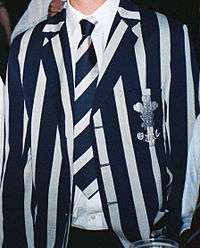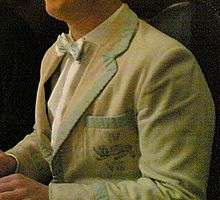Sporting colours
Sporting colours or just colours[1] (sometimes with a modifier, e.g. club colours or school colours) are awarded to members of a university or school who have excelled in a sport. Many schools do not limit their use to sport but may also give colours for academic excellence or non-sporting extra-curricular activities,[2][3][4] Colours are traditionally indicated by the wearing of a special tie or blazer.

Many university colours are known by the name of the colour used, which is usually the colour worn by the university's sports teams, e.g. Blue at Oxford and Cambridge, Palatinate at Durham or Purple at London. These are similar to the varsity letters awarded by American universities.
The level of representation required for the award of a colour varies between the different schemes. A full Palatinate at Durham, a Royal Blue at Liverpool or Full Colours at Cardiff require a student to have represented their country,[5][6][7] while at Oxford the requirement for a full Blue is to have represented the university in a varsity match against Cambridge in an eligible sport.[8] In many colour award schemes, it is possible to receive a half colour. These are normally given for lower levels of achievement than a full colour.
History
University colours were first introduced in the second University Boat Race between Oxford and Cambridge in 1836.[9] Durham adopted palatinate purple for its degree hoods at about the same time. At Cambridge, teams would seek permission of the boat club to use their blue colour; by the 1860s the established sports with full blue status were rowing, cricket and athletics. In 1884, the rugby and football clubs awarded themselves blues following their varsity matches (against Oxford), leading to a debate at the Cambridge Union that was decisively lost by the boat club. The hockey club also gained full blue status (in 1894) before the system was formalised by the establishment of the blues committee in 1912.[10] The award of Palatinates for sports at Durham dates to at least 1883, when the cricket "Eleven" were permitted to wear the "university coat" (i.e. blazer) of palatinate purple target than the claret coat of the club,[11] and the award of both Palatinates and half Palatinates was well established by the end of the century.[12] Manchester adopted maroon in 1905.[13]
University colours
Different universities award different colours, often based on the colour worn by their athletes. Sometimes these are known by the colour used, but they may also simply be known as "colours". These include:
- Aberdeen: Blue[14]
- Bath: Blue[15]
- Birmingham: Blue[16]
- Bristol: Red[17]
- Cambridge: Blue
- Cardiff: Colours[7]
- Dublin: Pink or Colours [18]
- Durham: Palatinate[19]
- Edinburgh: Colours[20]
- Glasgow: Blue[21]
- Heriot-Watt: Blue[22]
- Leeds: Colours[23]
- Liverpool: Blue or Colours[24]
- London: Purple[19]
- Loughborough: AU Colours[25]
- Manchester: Maroon[13]
- Oxford: Blue
- Robert Gordon: Blue[26]
- St Andrews: Blue or Colours[28]
- Sheffield: Colours[29]
- Stirling: Blue or Colours[31]
Gallery
 Oxford University, Oxford University Rifle Club Half Blue blazer and tie.
Oxford University, Oxford University Rifle Club Half Blue blazer and tie. Cambridge University Half Blue blazer and bow tie.
Cambridge University Half Blue blazer and bow tie. An example of a blazer pocket from Carey Baptist Grammar School with school colours in umpiring and musical theatre, as well as house colours and music insignia. Pockets are a common method of displaying awards.
An example of a blazer pocket from Carey Baptist Grammar School with school colours in umpiring and musical theatre, as well as house colours and music insignia. Pockets are a common method of displaying awards.
See also
References
- "colour Meaning in the Cambridge English Dictionary". dictionary.cambridge.org. Retrieved 2017-07-07.
- "School Colours". Woking High School. Retrieved 11 June 2019.
- "Colours Awards". Stirling High School. Retrieved 11 June 2019.
- "School Colours". Marr College. Retrieved 11 June 2019.
- Dominic Thurlow-Wood (23 June 2014). "Palatinate Ball signs off a record-breaking year for Team Durham". Palatinate.
- "The University of Liverpool Athletic Union: Constitution & Guiding processes" (PDF). University of Liverpool. pp. 17–18. Retrieved 11 June 2019.
- "Athletic Union Awards Criteria" (PDF). Cardiff University Students' Union. Retrieved 11 June 2019.
- "Varsity and Blues Awards". University of Oxford. Archived from the original on 25 April 2018. Retrieved 11 June 2019.
- "Oxbridge Blue. How to win the varsity match". The Field. 7 April 2015. Retrieved 11 June 2019.
- Christopher Thorne (10 July 1996). "Blues and the Blues Committee: Some historical notes" (PDF). Cambridge University Blues Committee. Archived from the original (PDF) on 16 July 2011.
- "Cricket". Durham University Journal. Durham University. 5 (9): 108. 26 May 1883.
- "The Palatinate". Durham University Journal. Durham University. 13 (4): 83. 14 May 1898.
- "University of Manchester, Athletic Union Archive". Archives Hub. Jisc. Retrieved 11 June 2019.
- "University celebrates top Athletes at 2015 Sports Ball". University of Aberdeen. 13 February 2015. Retrieved 11 June 2019.
- "Blues 2018". Bath Students' Union. Retrieved 11 June 2019.
- "Sports Awards". University of Birmingham. Retrieved 11 June 2019.
- "Students win prestigious sporting awards". University of Bristol. 7 June 2018. Retrieved 11 June 2019.
- "Jargon Buster". Trinity College Dublin. Retrieved 11 June 2019.
- Nick Collins (12 February 2011). "The quirks of Oxford and Cambridge". The Telegraph.
- "Colours". Retrieved 11 June 2019.
- "Constitution". Glasgow University Sports Association. Retrieved 11 June 2019.
- "Dress code". Heriot-Watt University. Retrieved 11 June 2019.
- "Sports Colours Awards 2018". University of Leeds. Retrieved 11 June 2019.
- A five-tier system of Royal Blue, University Blue, Full Colours, Half Colours and Club Colours[6]
- "AU Colours". Loughborough Students' Union. Retrieved 11 June 2019.
- "Sports Awards". RGU:Union. Retrieved 11 June 2019.
- "Blues and Colours". Saints Sport. University of St Andrewsaccessdate=11 June 2019.
- A three-tier system of Full Blue, Half Blue and Colours[27]
- "Sports Awards". University of Sheffield. Retrieved 11 June 2019.
- "Blues and Colours Code". Stirling Students' Union. Retrieved 11 June 2019.
- A three-tier system of Full Blue, Half Blue and Colours[30]